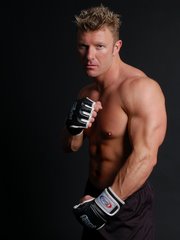workout series: baby got backThe muscles of the back are important for many activities as well as maintaining good posture and balance. Whether your sport involves swinging a bat, throwing a basketball, smacking a puck or just lifting groceries out of the trunk of your car... strong back muscles can improve performance and reduce your risk of injury. Even if you don't want "big wings" like Arnold... strengthening your back can make everyday activities easier and help you feel great. |
| Incorporating these exercises into your regular workouts can help you develop your back muscles. Periodically change the exercises and/or amount of weight that you lift (depending on your goals) to avoid plateaus and keep your muscles stimulated. Don't neglect other parts of your body. It's important to do a full-body workout to develop a well-rounded look and prevent muscular imbalance. |
| As with any resistance training program, how you lift depends on your specific goals. If you don't know how to lift to reach your goals, talk to one of our fitness professionals for more information. If you've had any type of back pain or previous back injuries you should check with your doctor for specific limitations prior to starting a new workout program. |
| The muscles involved, how they attach to the body and the movements they perform are important for any resistance training exercise. Performing an exercise incorrectly or forcing the body into an unnatural position will reduce the effectiveness of the movement and greatly increase your risk of injury. If you have any questions ask for a demo from one of our fitness professionals. Keeping the the "action" and "attachment" in mind while performing an exercise can help you maintain the proper technique. |
lower backMuscles: the spinal erectorsAttachment: these muscles originate on the pelvis, vertebrae and ribs and attach to the ribs, vertebrae and back of the skull. Action: extension and lateral flexion of the spine. |
lower back exercises:
|
upper backMuscles: latissimus dorsi, teres major and rear deltoid.Attachments: the lats originate on the vertebrae and pelvis and attache to the upper front part of the humerus (bone of the arm); the teres major and the rear deltoid originate on the shoulder blade and attach to the upper bone of the arm (humerus). Action: all three muscles bring the arm closer to the body (as in a pull up) and also extend the shoulder. |
upper back exercises: |
pull downs:
* Skip the behind the neck pull-ups and behind the neck lat pull-downs. These exercises are less effective based on the physiology of the muscles (how they attach and the movement they perform). Behind the neck movements also increase the risk of injury because the shoulder joint is placed in an unnatural position increasing stress to the joint during movement. Leaning your head forward to complete a behind the neck exercise also places the head/neck in an unnatural position and even more risk of injury. |
rows:Wide-Grip Bent Over Barbell Row: using a straight barbell, stand with your feet close together and your knees slightly bent. Bend over slightly at the waist and keep your back straight. Limiting movement in your body, pull the barbell up towards your abdomen. Repeat 8-12 reps. Rest and repeat according to your specific goals/abilities. ** Keeping your shoulder blades in their natural position throughout a row exercise creates a more effective exercise. When your shoulder blades extend forward the muscles must pull the shoulder blades back into their natural position before the exercise movement can be performed. Returning to a natural shoulder position reduces the amount of time resistance is applied to the muscle and reduces the efficiency of the exercise. |
straps or no straps?Because your back muscles can lift more weight than your grip can usually handle, many people like to use straps to increase the amount they lift. Some people don't like straps because they don't allow you to develop grip strength. So who's right? Depends on your individual goals and why you're lifting. If grip strength is important to you or for a specific sport (i.e. rock climbing) then you shouldn't use straps. If your goal is overall health and fitness and grip strength isn't an issue, straps can improve your workout for the larger muscle groups. It all depends on your goals. |
If you're interested in fitness, bodybuilding, loosing weight, wanting to be fit, or just interested in fitness! You came to the right place! Stay in touch with all the latest news! Check out the Blog Archive! :)

Wednesday, July 25, 2007
Workout Series: Baby got back
Wednesday, July 18, 2007
Workout Series: The Abominable Abdominal
workout series: the abominable abdominalWashboard abs are the hottest item in the fitness world and sought after by both men and women. Washboard abs require a lot of discipline, healthy low fat diet and a fairly low percentage of body fat. Many people have an excellent abdominal routine but they also have a thin layer of subcutaneous fat covering up all their hard work. It's important to burn off this layer of fat to see the fruits of your labor. |
| Working your abs smarter, not longer will help you get in a good workout without doing 250 crunches. For many, the crunch is the only exercise in their abdominal workout and they just keep piling on more sets and reps to reach their fitness goals. If you want to develop your abs, you have to use different exercises just like you would with any other muscle. Try some of the abdominal exercises below to add variety and get a good ab workout. |
| The Muscles: there are 5 muscles that make up the Abominable Abdominal. The rectus abdominus originates at the pubic bone and attaches to the lower portion of the ribs. Its job is to flex the spine and shorten the distance between the rib cage and the pubic bone. The internal and external oblique muscles (there?s 1 internal and 1 external oblique on each side of the rectus abdominus) are also between the ribs and the pubic bone and they laterally flex the spine (same as above but adding a sideways motion). |
| Hanging Knee Lift: these can be done from an overhead pull-up bar. This exercise is often done incorrectly, the key is to: use a slow controlled movement, limit upper body movement and not moving you hip joints during the exercise. The abdominal muscles attach to the pelvis not the legs; lifting your knees at the hip joint is a great exercise for your hip flexors but not your abs. Keep your knees and hips stable and lift the pelvis, legs and knees as one unit towards your chest. |
| The Bicycle: This is a slow, fluid movement that stimulates your abdominal muscle and obliques by crunching and twisting and alternately extending your legs. This may sound a little confusing, but remember that all 4 limbs should be moving at the same time. Lying on your back with your hands behind your head, contract your abs and lift your shoulders off the floor. Slightly twist your torso and point your right elbow towards your left knee as you?re lifting your left knee up until it forms a 45-degree bend (your leg should remain slightly bent). Slowly twist your torso to point your left elbow towards your right knee as you lower your left leg and lift your right knee until it forms a 45-degree angle. Hold the extended leg off the floor until you bring it back to the 45-degree bend. Do as many as you can and go as slow as possible. |
| Crunch: the crunch can still be a great exercise to include with other abdominal workout. Try variations to the regular crunch to stimulate your muscles differently for better results. Lying on your back, rest your left foot on your right knee and crunch your right elbow towards your left knee. Repeat with the opposite side. Using an exercise ball while crunching is another way to stimulate your abs a little differently and you?ll also use other trunk stabilizing muscles to maintain your balance. |
| Reverse Crunch: as the name implies, this is performed by crunching the lower portion of the abdominal muscles up towards your chest. Start by lying on your back on the floor with your hands at your sides for balance. You knees should be bent at a 90-degree angle and your upper thighs should be perpendicular to your body. Keep your hip joint and knees in this position throughout the movement. Slowly roll your hips and legs off the floor and flex your lower spine to raise your lower back off the floor. Think about lifting your hips off the floor using your abs and avoid "jerking" into motion and using momentum to complete the exercise. Slow controlled movements will limit risk of injury and give your abs a great workout. This is an advanced exercise and using proper form is important for the effectiveness and to limit injury. Moving your hip joint and knees puts stress to the lower back and should be avoided. |
| All of these exercises should be done in a slow controlled manner and remember to breath. Going slow helps you avoid building momentum and reduces the risk of injury to your back and spine. If you?re placing your hands behind your head for any abdominal exercises, be careful not to use your arms to lift your head and shoulders. Not only does this place stress on your neck and spine; you?re also removing some of resistance from your abs. |
10 tips for exercise success
10 tips for exercise success
How many times have you started an exercise program and then just quit going? Well... you're not alone! Many people start with great intentions but soon lose motivation and end up avoiding the gym altogether. We want to see everyone succeed so we've put together 10 tips that we've found useful for starting and sticking with an exercise routine! The following 10 tips to weight reduction don't involve buying expensive foods or hiring a personal trainer. Instead, they involve common sense.- Choose activities that are fun. Exercise doesn't have to be a chore and the more fun it is, the more likely you are to stick with it.
- Variety is the spice of life! Don't just find one thing and stick to it... your guaranteed to get bored eventually. Find a couple different types of exercise that you enjoy (swimming, biking, weight training, yoga, group exercise classes, etc.) and mix it up!
- Keep a record of your activities. Set small "achievable" milestones and reward yourself periodically. Nothing motivates and keeps you going like success!
- Make it a lifestyle! Short-term diets and fitness kicks don't work. Lifestyle changes that become part of your normal routine are important for long-term success.
- Watch the clock. Pick a time that's convenient and try to stick to it. If you get used to working out before work or walking during your lunch hour... you're more likely to stick with it.
- Don't be too hard on yourself. If you miss an exercise opportunity, try to work something else in rather than feeling down. If a lunch meeting interferes with your regular walk... go for a walk after dinner.
- Stay entertained. Music is a great motivator and can make exercise more fun. Mix your own CD's with your favorite music or books on tape and take them along when you're working out. Many people also like to watch TV or catch up on their soaps while on a treadmill. Whatever it takes to keep up with the program.
- Surround yourself with supportive people. Share your activity with others who want to see you succeed and will be encouraging. It may be a friend, family member, or neighbor. You may run with a co-worker over lunch or find a workout partner. If you're at the gym at the same time everyday, look for people that may have similar goals... since your schedules are the same, maybe he/she is looking for a workout partner?
- Slow and steady wins the race. Don't risk injury by pushing yourself too hard too quickly. Start with low to moderate level activities and gradually increase the duration and intensity of your workouts as you become more fit.
- But... don't get lazy! While pushing yourself too hard is bad... not doing enough is equally bad! There is a fine line between staying on a plateau and providing enough stimulus so your body will grow. You should gradually increase the amount of weight you lift, the length of your cardio exercise, etc. to keep you moving towards your goal. If your goal is overall fitness, you should work up to exercising three or four times per week for 30-60 minutes.
Tuesday, July 10, 2007
Spot-On Abs Training
Perform these ab routines three times a week at the end of your regular workouts. We suggest doing them on Monday, Wednesday and Friday to allow adequate recovery between sessions. Continue training other muscle groups as you normally do; however, since you're training abs Monday, Wednesday and Friday, we also recommend that you follow a five-day, Monday through Friday training split and take the weekend off, as in "Spot-On Split" (below).
Cardio should be done on a treadmill, if possible, as this has been shown to be just about the most effective form of cardio for maximizing the amount of fat burned. Another way to get the most out of fat-melting is to perform your cardio in the following manner: After a two-minute warm-up, get into high gear and do high-intensity cardio (about 85% of your maximum heart rate, or MHR) in the first half of your workout, then reduce the intensity (about 60% MHR) during the second half. (See "Spotty Cardio" at right for a sample cardio workout following this method.) Not only does research show that this type of cardio activity burns more fat during a workout, but higher-intensity cardio has also been found to burn the most fat after training is over - and that, after all, is the ultimate goal.
Is this program grueling? Yes. But do you want abs by the time summer is here, or would you prefer spending another vacation wearing a tank top at the beach to flaunt your guns and hide your no-show abs? Thought so. M&F
SPOT-ON SPLIT
Try this sample training split for the next six weeks while following the Spot-On Abs Program (below). Perform your regular workouts for other bodyparts while following this split (or one similar).
| Day | Muscles Trained |
| Monday | Chest, abs, cardio |
| Tuesday | Legs, calves |
| Wednesday | Shoulders, traps, abs, cardio |
| Thursday | Back |
| Friday | Biceps, triceps, abs, cardio |
SPOT-ON ABS PROGRAM
These workouts become more challenging as the weeks go by, progressively conditioning your abs so they can handle the highest volume of training during Weeks 5 and 6. Remember, it's not about how many total sets you complete (this will vary from person to person) but rather that you're able to perform sets one after the other for the entire period specified. For all exercises, keep your technique strict and move at a medium pace - don't hurry.
Week One
Do each of the following exercises for 10 reps (or until you reach failure) in giant-set fashion (doing the exercises one after another without resting between each) for 15 minutes:
Reverse Crunch
Standard Crunch
Oblique Crunch
Rope Crunch
Week Two
Do each of the following exercises for 12 reps (or until failure) in giant-set fashion for 20 minutes:
Hanging Knee Raise
Reverse Crunch
Standard Crunch
Oblique Crunch
Rope Crunch
Weeks Three & Four
Do each of the following exercises for 15 reps (or until failure) in giant-set fashion for 25 minutes:
Hanging Knee Raise
Reverse Crunch
Standard Crunch
Oblique Crunch
Oblique Crossover Crunch
Rope Crunch
Weeks Five & Six
Do each of the following exercises for 20 reps (or until failure) in giant-set fashion for 30 minutes:
Hanging Knee Raise
Reverse Crunch
Double Crunch
Standard Crunch
Oblique Crunch
Oblique Crossover Crunch
Rope Crunch
SPOTTY CARDIO
Try this sample cardio workout immediately following the Spot-On Abs workout. It maximizes fat-burning both during and after each session, alternating high intensity in the first half with low intensity in the second.
| Intensity (% Max HR) | Time |
| 50% (warm-up) | 2 minutes |
| 85% | 13 minutes |
| 60% | 13 minutes |
| 50% (cool-down) | 2 minutes |
















